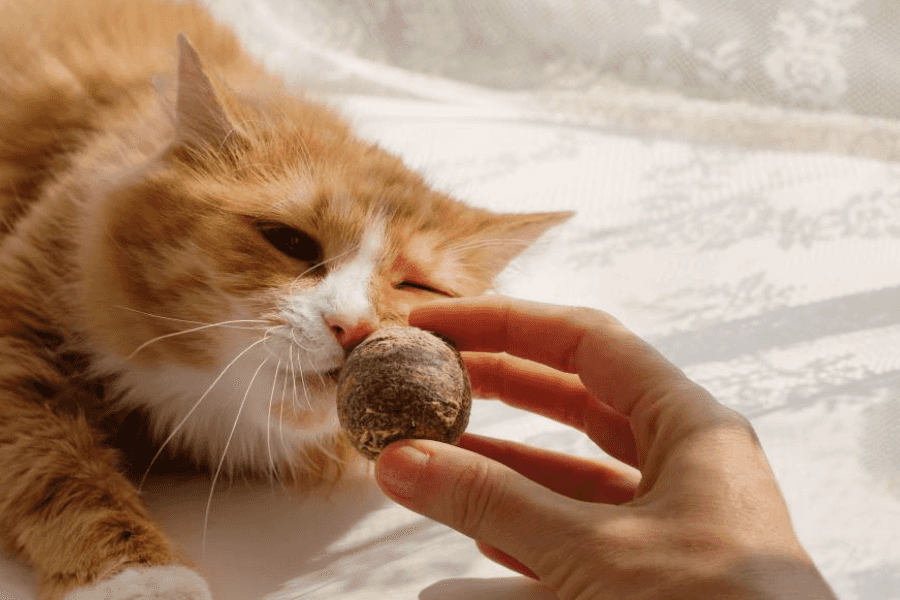What Happens When Cats Eat Catnip? Here Are The Benefits

Catnip is well-known for its intoxicating effects on cats. When your furry friend gets a whiff of this aromatic herb, they often go crazy with excitement and pleasure. ![]()
But what exactly is catnip and what causes this euphoric reaction in cats? Can cats eat catnip or is it only for smelling?
As a cat owner, it’s helpful to understand what happens when cats indulge in catnip so you can use it safely and effectively. In this article, we’ll explore everything you need to know about the effects of catnip, including its health benefits and proper dosage.

Catnip contains an essential oil called nepetalactone that causes a euphoric reaction in about 2/3rds of cats when inhaled or ingested. Not all cats respond to catnip; sensitivity is hereditary and involves a specific neural receptor. Kittens under 3 months old typically don’t react to catnip.
What Is Catnip?
Catnip, scientifically known as Nepeta cataria, is a herbaceous mint native to parts of Europe, Asia, and Africa. It’s been naturalized throughout North America and grows wild in many areas. The plant features gray-green foliage with lavender flower spikes.
Catnip belongs to the Lamiaceae or mint family. In fact, it’s closely related to well-known culinary herbs like basil, oregano, rosemary, and of course, mint. Catnip has a pleasant, minty aroma reminiscent of oregano.
The name catnip refers to the plant’s intoxicating effects on cats. Other common monikers for catnip include catmint and catwort.

Catnip contains an essential oil called nepetalactone that causes a euphoric reaction in about 2/3rds of cats when inhaled or ingested. Not all cats respond to catnip; sensitivity is hereditary and involves a specific neural receptor. Kittens under 3 months old typically don’t react to catnip.
Catnip Effects on Cats
So what happens when cats get into catnip? Reactions can vary but often include some of the following behaviors:
Rolling - Cats will roll and writhe on the floor when exposed to catnip. They’ll also rub their face and body in it ecstatically.
Chewing - Cats may lick or gently chew on catnip plants or toys. Some ingest catnip as well.
Hyperactivity - A catnip high will send many cats racing and leaping around the room in a frenzied, kitten-like manner. They’ll often engage in solo “mad cap” play.
Affection - Some cats become extremely loving, rubbing against owners and furniture while under the influence of catnip.
Vocalizing - Mewing, growling, and other odd vocalizations are common during catnip euphoria.
Drooling - Excessive salivation or drooling sometimes occurs too.
Aggression - A small percentage of cats react aggressively to catnip, especially toward other pets. This likely stems from overstimulation.
Whatever form the reaction takes, a catnip high usually lasts between 5 and 15 minutes. Cats will then lose interest as the initial intense reaction wears off. It takes at least an hour for cats to respond to catnip again.

Not all cats respond to catnip. Lack of sensitivity is hereditary and found in about 1/3 of domestic cats. Kittens also don’t react until around 6 months to 1 year old.
As cats mature, they may eventually outgrow the stimulant effects.
Health Benefits of Catnip
There’s more to catnip than just the intoxicating high it produces. Catnip has several health benefits for cats when used appropriately:
Natural Sedative
When ingested, catnip has a sedative effect instead of a stimulant effect. The herb helps relax the nerves and ease anxiousness. Catnip can calm cats in stressful situations like vet visits or travel. Many cat owners give their pets catnip toys to keep in carriers.
Digestive Aid
Catnip has traditional uses as a digestive aid for settling an upset stomach and relieving gas. The soothing, anti-spasmodic properties of catnip’s essential oils help relieve gastrointestinal discomfort.
Repels Bugs
Catnip oil makes an effective natural bug repellent. The strong smell deters mosquitoes, flies, and other insects. Some pet owners will rub dried catnip on their cat’s fur to help keep bugs at bay. Growing catnip around the yard can also help repel insects.
Stimulates Play
For cats who react positively, catnip can encourage playful behavior. Catnip provides mental stimulation and exercise. Pet owners often use catnip toys to engage their cats in active solo play. The herb satisfies cats’ natural prey drive and hunting instincts.

Overall, when used properly, catnip is non-addictive and safe for cats. The active compound binds to receptors in the cat’s brain which provide temporary pleasure and stimulation.
Proper Catnip Dosage
Catnip dosing depends on the form being used. When giving your cat catnip, start with a small amount and monitor their reaction:
Fresh leaves - Give your cat 1-2 fresh catnip leaves to start. They can nibble the potent fresh leaves.
Dried leaves - Start with 1/4 to 1/2 teaspoon of dried catnip leaves.
Catnip toys - Allow limited play time with store-bought catnip toys, 10-15 minutes per session.
Catnip spray - Spritz a toy 2-3 times and let your cat play for a short session.
Catnip oil - Use just 1-2 drops of catnip oil to scent a toy. Oils are highly concentrated.
Cats will naturally turn away or lose interest when they’ve had enough catnip. Limit catnip to no more than 2-3 times per week for the best results. Always supervise your cat anytime catnip is given to prevent overindulgence.
Too much catnip can cause vomiting, diarrhea, or upset stomach from irritation of the digestive tract. Serious toxicity however is unlikely. Discontinue use if any adverse reaction occurs and contact your vet with concerns.

Moderation is key when giving cats catnip to enjoy the benefits safely. Follow suggested serving sizes based on the catnip form. Cats vary in sensitivity as well, so tailor usage to your individual pet.
Can Cats Eat Catnip?
Yes, cats can eat catnip without any harm. The herb is non-toxic for felines. Many cats will readily nibble fresh catnip leaves when given the chance. Others may lick and chew on catnip toys.
Eating catnip however produces different effects than just smelling it.
When inhaled, catnip has a stimulating reaction. But when eaten, catnip acts as a sedative and digestive aid. Consuming the herb helps relax the body and aid the stomach.
So feel free to share a few fresh catnip leaves with your cat. It makes a nice interactive treat. Just keep portions small. Too much can cause an upset stomach. Dried catnip can also be sprinkled on food in tiny pinches.
Always supervise your cat with access to catnip plants. Cats are drawn to nibble the leaves but may quickly overindulge if given free reign. Clip off a few leaves at a time to share safely.

Responsible snacking on catnip leaves is fine for cats. But eating large quantities can cause digestive upset. Use good judgement and limit intake when feeding catnip to your feline friends.
What Are the Risks of Catnip?
Catnip is generally very safe for cats when used properly. But there are a few potential risks to be aware of:
Overeating - Eating too much catnip can upset the stomach. Always limit your cat’s intake.
Diarrhea - Loose stools or diarrhea could occur if a large amount of catnip is eaten. Discontinue use if this occurs.
Allergies - Extremely rare, but some cats may have allergies to catnip, as with any substance. Watch for signs like reddened skin, excessive scratching, etc.
Aggression - Some cats can become aggressive on catnip, especially toward other pets. Separate fighting cats immediately.
Hyperactivity - Excess play and activity can result in injuries, especially with excitable cats. Provide safe outlets for their energy.
Messiness - Cats often spread catnip all over when rolling in it. Be prepared for loose catnip on carpets, furniture, etc.
The key is moderation. Health risks are minimal when catnip is given in limited, controlled amounts. Stop use if any unusual reaction occurs and see your vet if your cat shows signs of illness after catnip consumption. Introduce new forms of catnip slowly and supervise your pet during use.

While generally benign when used wisely, catnip can pose hazards if cats ingest large amounts. Curb risks by closely monitoring your cat any time catnip is given. Only provide limited quantities needed for temporary stimulation and enjoyment.
FAQs About Catnip
Still have questions about cats and catnip? Here are answers to some frequently asked questions:
Why does catnip make cats go crazy?
Catnip contains essential oils called nepetalactones that mimic feline pheromones and bind with receptors in a cat’s nose and brain. This triggers a pleasurable neurologic reaction that makes cats go a little crazy with happiness. The catnip high lasts 5-15 minutes.
Is catnip bad for cats?
No, catnip is non-toxic and safe for cats when used properly in moderation. Too much can cause upset stomach. Some cats may have rare allergic reactions. Most cats enjoy harmless temporary highs from catnip.
Is catnip addictive for cats?
No, cats cannot get addicted to or dependent on catnip. The stimulating compounds bind to receptors in the brain, providing temporary pleasure. But there are no addictive chemicals. Cats respond intermittently based on certain genetic and developmental factors.
Can kittens have catnip?
Kittens under 6 months old typically do not respond to catnip. Their brains have not fully developed the neural receptors affected by catnip oils. Some kittens may start responding around 3-6 months old. There’s no harm in exposing young kittens to catnip.
How much catnip is safe for cats?
Catnip dosage depends on form. Start with 1-2 fresh leaves, 1/4 tsp dried leaves, 2-3 sprays on a toy, or 1-2 drops of oil. Cats only need a small amount of catnip to gain sensory stimulation. Limit catnip to a few times per week.

Catnip FAQs help clarify misconceptions about catnip safety and effects. When used properly, catnip is a harmless source of fun and stimulation for most cats. Learning the basics allows cat owners to help their pets enjoy it responsibly.
Conclusion
When cats eat catnip, roll in it, or inhale its aromatic oils, an intense reaction occurs. This minty herb acts as both a stimulant and sedative, providing temporary euphoria and relaxation. It satisfies cats’ senses and hunter instincts.
Not all cats respond, but most who do will enjoy catnip immensely when given occasionally. Make sure to introduce catnip slowly and follow suggested serving sizes. Monitor your cat during use.
While relatively safe, catnip can cause stomach upset if too much is consumed. Curb risks by limiting intake. When used wisely, catnip is a fun supplement adding excitement and entertainment to a cat’s life!
In summary, catnip is a popular herb that induces a euphoric reaction in many cats. Used appropriately, it can provide health benefits and safe enjoyment. But be cautious of overindulgence which can cause adverse effects. Overall, catnip is a harmless treat when given in moderation.
Tags
Share
Table Of Contents
Related Posts
Quick Links

